2012 Wildlife Archives: Incredible Findings and Photos
Please read over our past months of great sightings. We welcome your questions about our beautiful island. We would also love to hear from you! Get outside and share your photos and stories with us at Nature_Program@KiawahResort.com.
November 14, 2012 ~ American White Pelican (Pelecanus erythrorhynchos)
Flock of 20 White Pelicans were observed by Naturalist Brad Schmoll circling over Mingo Point.
November 9, 2012 ~ American White Pelican (Pelecanus erythrorhynchos)
Today on our ACE Basin Boat Tour our group spotted American White Pelicans. Not a normal visitor of Kiawah or even South Carolina, the White Pelican usually spends its breeding season on the Northern Lakes of the Great Plains, its migration west of the Mississippi and winters along the coasts from Florida west. Our local pelican is the Brown Pelican but the American White Pelican is easily distinguished from its darker cousin; although if you see the White Pelican in flight it looks a little similar to the Wood Stork. An interesting fact about the White Pelican is that it does not dive for fish like the Brown Pelican does. Instead, it dips its head underwater to scoop up fish. Take a tour on the water from Mingo and keep two eyes out for this beautiful bird.
November 5, 2012 ~ Bald Eagle
An immature Bald Eagle has been frequenting the Egret Pond area.
October 29, 2012 ~ Green Sea Turtle (Chelonia mydas), “Mini Ming Update”
Mini Ming is doing well in a filtered tank of water. Surprisingly, she is neutrally buoyant, which is odd considering she was rescued due to flotation issues. Ming is loving her healthy hospital diet of fish and various veggies, and is passing regular formed fecals.
October 23, 2012 ~ Green Sea Turtle (Chelonia mydas), “Mini Ming”
From the South Carolina Sea Turtle Hospital Blog…
Age: Juvenile
Sex: Female
Weight: 1.9 kg (~4 lb.)
Case History: Inquisitive naturalists from Kiawah Island’s Night Heron Nature Center noticed something small floating in the water around the dock at Mingo Point and, luckily, decided to investigate. The floating object turned out to be a tiny green sea turtle we’ve named “Mini Ming.” Swimming weakly and unable to dive, Mini Ming was rescued from the water and transported to our Sea Turtle Hospital by biologists from SCDNR.
Treatment: Upon arrival, Mini Ming received a full physical examination, which didn’t reveal any external wounds or abnormalities. After blood was drawn, fluids were administered subcutaneously to combat dehydration, and Ming was started on antibiotics. Radiographs showed a GI tract full of food, as well as bone lysis in Ming’s left carpus (wrist), which is concerning.
Special thanks to Naturalists Brad Schmoll and Brogin Von Skoik for rescuing this beautiful turtle.
October 10, 2012 ~ American Alligator (Alligator mississippiensis)
The KICA Lakes Department evaluated Kiawah’s unsuccessful alligator nests. After digging the nest at Night Heron Park, they began counting the overdue, un-hatched eggs, when an 8 to 9 foot alligator crawled up and proceeded to eat the rotten eggs. We believe this was a male alligator not the female alligator who had laid the nest; an assumption based not on appearance but on behavior. For shortly after the alligator consumed several eggs, we witnessed it attempt to snatch one of the yearling gators who was basking in the sun on a floating log (he lives another day).
October 8, 2012 ~ Feather Report
Town Biologists had their most productive banding day ever with 272 birds banded and 16 recaptures of 26 species. Some highlights included a Gray-cheeked Thrush, Northern Parula (19), Magnolia Warbler (10), Cape May Warbler (5), Indigo Bunting (12) and a bunch of Common Yellowthroats (131).
To see the full list and some photos, take a look at their blog: http://www.kiawahislandbanding.blogspot.com/
September 30, 2012 ~ Atlantic Flying Fish (Cheilopogon melanurus)
A guest brought to the Nature Center an interesting looking fish she found washed up on the beach. It was determined to be an Atlantic Flying Fish! Flying fish are commonly found in warm equatorial waters around the world and have a unique body plan that evolved for them to successfully escape predation by larger fish. Flying fish have a slender torpedo shaped body that allows them to propel themselves out of the water. These fish are able to reach approximately 37 miles per hour underwater before they take flight in the air. They have large wing shaped pectoral fins that help them glide in the air for a long period of time (some can glide for about 655ft)!! This body shape and plan makes it perfect for them to stay safe from predators like Mackerel and Tuna that are lingering in the ocean below. Even though flying fish are seen mainly offshore by fisherman, Naturalist Matt Arnold reported seeing one recently in the Kiawah River on a kayaking trip!
September 25, 2012 ~ Brunner’s Mantis (Brunneria borealis)
 A new mantid species for Kiawah has been discovered on Captain Sam’s Spit! It was discovered by a bird banding assistant who was out with Aaron Given and the banding technicians in the early morning. The slender Brunner’s Mantis is native to the Southern U.S, but this is the first to be documented on Kiawah. It’s defining characteristic is the presence of small serrations on its thorax. Some call this species the walking stick mantis due to its uncanny resemblance to the walking stick insects.
A new mantid species for Kiawah has been discovered on Captain Sam’s Spit! It was discovered by a bird banding assistant who was out with Aaron Given and the banding technicians in the early morning. The slender Brunner’s Mantis is native to the Southern U.S, but this is the first to be documented on Kiawah. It’s defining characteristic is the presence of small serrations on its thorax. Some call this species the walking stick mantis due to its uncanny resemblance to the walking stick insects.
A fun fact about the Brunner’s mantis–it is the only species of mantid that reproduces through parthenogenesis! This means that reproduction is asexual-the embryos develop without fertilization, and when they hatch from the egg case, they are all female. There are no known males of this species!!
September 20, 2012 ~ Zebra Longwing (Heliconius charithonia)
Just spotted our first Zebra Longwing of the season. It was feeding on lantana outside the Cougar Point Golf Course.
September 20, 2012 ~ Feather Report
Guide: Matt Arnold
Tour: Back Island Birding
Species Highlights: Great Egret; Snowy Egret; Wood Stork; Carolina Chickadee; Tufted Titmouse; Northern Cardinal; Royal Tern; Laughing Gull; Osprey; Willet; Short-billed Dowitcher; Eastern Bluebird; House Finch; Cape May Warbler; Yellow Rump Warbler; Pine Warbler; Prairie Warbler; Painted Bunting (female); Nashville Warbler; American Redstart; Canada Warbler (female); Yellow-throated Vireo.
September 15, 2012 ~ Spiny Lobster (Panulirus argus)
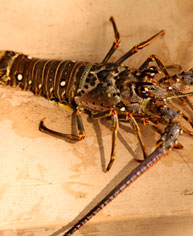 Two lobsters were captured in our crab trap in the Kiawah River. They are one of four dozen or so species of Spiny Lobsters found throughout the world. Spiny Lobsters lack the frontal claws, typically associated with lobster, and many times ends up on your plate if you order “lobster tail”. Our local species is the Caribbean Spiny Lobster found from NC to Florida in the US. At this size are typically found farther offshore, so to find them in the Kiawah River was a special treat.
Two lobsters were captured in our crab trap in the Kiawah River. They are one of four dozen or so species of Spiny Lobsters found throughout the world. Spiny Lobsters lack the frontal claws, typically associated with lobster, and many times ends up on your plate if you order “lobster tail”. Our local species is the Caribbean Spiny Lobster found from NC to Florida in the US. At this size are typically found farther offshore, so to find them in the Kiawah River was a special treat.
September 13, 2012 ~ American Alligator (Alligator mississippiensis)
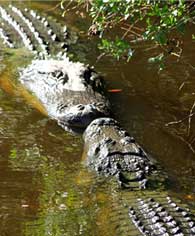 It was fascinating to watch our Night Heron female (whose nest should be hatching any time now) warn the male gator that he was intruding. After she bumped his nose she turned towards the shrubs and started to bellow…as he swam to the other side of the pond, she too followed and again bellowed. Keep your eyes on this pair to see if anything else unfolds.
It was fascinating to watch our Night Heron female (whose nest should be hatching any time now) warn the male gator that he was intruding. After she bumped his nose she turned towards the shrubs and started to bellow…as he swam to the other side of the pond, she too followed and again bellowed. Keep your eyes on this pair to see if anything else unfolds.
September 13, 2012 ~ Feather Report
Guide: Brogin Van Skoik
Tour: Back Island Birding/Nature Walk
Locations: The Preserve, Osprey Point, Ocean Course Driving Range/Beach, Turtle Pond.
Weather: 80, Cloudy with morning showers, little wind, held from 8:30-11:30AM
Highlights: Not a huge day for birds but great for wildlife. We started with a walk through Night Heron Park and observed a group of bluebirds hiding from the morning drizzle. As we got to The Preserve the rain had stopped and allowed us to climb the marsh tower where we observed a scattering of herons. This included a group of Tricolored Herons, a Great Blue Heron and Great Egrets. Amongst the egrets and herons several large fish were foraging in the marsh thrusting their dorsal fins out of the water. As we explored the Preserve we came upon an Eastern Mud Turtle (Kinosternon subrubrum) sitting in the damp vegetation. This was a great find and definitely worth the hike into the Preserve. We then stopped at the Ocean Course and observed a group of Killdeer foraging on the driving range adjacent to the beach. With Fall approaching the wildlife has been great so come check it out or take a tour with us and you never know what you will see!
Species: Eastern Bluebird, Brown Headed Nuthatch, Anhinga, Great Egret, Snowy Egret, Tricolored Heron, Green Heron, Turkey Vulture, Osprey, Mourning Dove, Red-bellied Woodpecker, Downy Woodpecker, American Crow, Carolina Chickadee, Northern Mockingbird, Northern Cardinal, Juvenile Black-crowned Night-Heron, Killdeer, Belted Kingfisher, Tufted Titmouse and Eastern Mud Turtle (Kinosternon subrubrum).
September 10, 2012 ~ Bottlenose Dolphin
River report from Captain Brad Schmoll:
Dolphin and birding activity was very good today. On our first trip we watched two mammas and two babies “hanging out” together. The babies appeared to be “playing” with each other? Not sure how else to describe it. One baby was a little bigger than the other. The babies swam next to each other; they swam into each other, and they breached the water around each other- as if they were wrestling or playing tag in the water. Play time I reckon!
The Sunset Cruise was perfect. Dolphin activity was very good. We reached the inlet and viewed the Sanctuary and Ocean Course. We turned Mrs. Valerie around to prepare for the perfect sunset that awaited us. From the moment we started heading back, we noticed that a bald eagle had just landed and was sitting on the Kiawah side of the inlet and facing Seabrook. Just a few seconds later, five dolphin violently rushed the fish onto the sandy bank as the eagle attempted to grab an appetizer. We see our brown pelicans do this all of the time, and it is so much fun to see. To witness one of our bald eagles waiting patiently and snatching stranded fish was just beautiful. Incidentally, the Sunset was perfect too!
September 8, 2012 ~ Southern Stingray (Dasyatis americana)
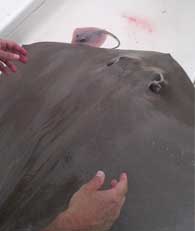 This huge female stingray was caught on a line during Captain John Ward’s fishing excursion. As the ray was pulled onboard to be freed from the hook, she gave birth to several stingray (one in the top left corner of photo). Mother and young were all safely released back into the marsh.
This huge female stingray was caught on a line during Captain John Ward’s fishing excursion. As the ray was pulled onboard to be freed from the hook, she gave birth to several stingray (one in the top left corner of photo). Mother and young were all safely released back into the marsh.
September 7, 2012 ~ Wood Stork (Mycteria americana) with American Eel (Anguilla rostrata)
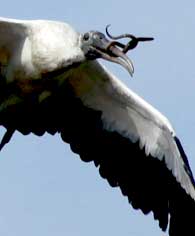 This awesome picture was taken by our Nature Photographer Jamie Rood. While out seeking a glimpse of the recently reported Roseate Spoonbill hanging out near Cassique, Jamie was able to capture this Woodstork enjoying an eel mid-flight! At first it was difficult to determine what the Woodstork was snacking on- -thoughts ranged from a large marine worm to a legless lizard, but upon further scrutiny, we determined the food item to be an eel. Woodstork’s use tactile feeding to capture their prey; this involves probing the mud at low tide and pulling out invertebrates and fish species. Another awesome discovery!
This awesome picture was taken by our Nature Photographer Jamie Rood. While out seeking a glimpse of the recently reported Roseate Spoonbill hanging out near Cassique, Jamie was able to capture this Woodstork enjoying an eel mid-flight! At first it was difficult to determine what the Woodstork was snacking on- -thoughts ranged from a large marine worm to a legless lizard, but upon further scrutiny, we determined the food item to be an eel. Woodstork’s use tactile feeding to capture their prey; this involves probing the mud at low tide and pulling out invertebrates and fish species. Another awesome discovery!
September 7, 2012 ~ Blue-winged Teal (Anas discors)
While in the field searching for another look at yesterday’s Roseate Spoonbill, we came upon a group of 17 Blue-wing Teal in an isolated pond just south of the Kiawah Island Bridge.
September 7, 2012 ~ American Alligator (Alligator mississippiensis)
On our Alligator Adventure tour, Naturalist Mel Musso and her group spotted a tiny gator in a pond at the Osprey Point Golf Course. For the 2012 season a gator nest had not been identified in this area, consequently, the KICA Lakes Department was notified. We are excited to announce the Lakes Department has confirmed the nest and located 15 hatchlings near the club house bridge.
September 6, 2012 ~ Roseate Spoonbill (Platalea ajaja)
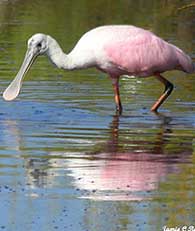
August 30, 2012 ~ Wood Stork (Mycteria americana)
This morning, several ponds on the western end of Kiawah experienced a fish kill. A natural event, Kiawah’s warm temps and overcast conditions have caused a decrease in dissolved oxygen, causing the fish to die. But nature is not wasteful! Birds, like these wood storks, are along the banks taking advantage of an easy meal.
August 29, 2012 ~Blue-winged Teal (Anas discors)
Town Biologists reported a flock of 11 Blue-winged Teal flying up the beach on the eastern end of the island. This is the first sighting of the season for this species. Blue-winged Teal are the earliest duck species to arrive in our area and we normally see our first flocks in late August each year.
August 24, 2012 ~ Painted Bunting (Passerina ciris)
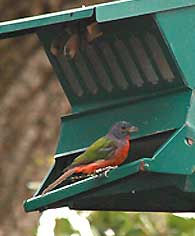 At Mingo Point, we were able to catch a glimpse of this banded molting male Painted Bunting. Although we cannot tell from this distance, there is a very good chance this individual was banded by Town Biologist, Aaron Given.
At Mingo Point, we were able to catch a glimpse of this banded molting male Painted Bunting. Although we cannot tell from this distance, there is a very good chance this individual was banded by Town Biologist, Aaron Given.
In birds, molting is the sloughing or shedding of feathers. According to Cornell Ornithology, molting occurs in response to a mixture of hormonal changes brought about by seasonal changes. The entire process is complex and many questions remain regarding how the process is controlled. A basic understanding of molting patterns can, however, be a useful aid in identifying many species and in determining their age.
To keep you up to date on all the exciting bird band research happening on Kiawah, Town Biologists have created a new blog…..check it out: http://kiawahislandbanding.blogspot.com
August 23, 2012 ~ American Alligator (Alligator mississippiensis)
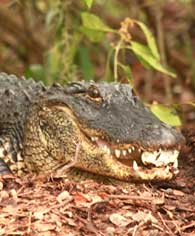 Wow! Amazing!! It’s hard to think of any words to describe a “Once in a Lifetime Experience”. After many hours of waiting today this mother gator finally began taking her precious eggs and hatchlings from the nest to the nearby pond (which was only a few feet away). It was incredible to see her gently scoop up one sometimes two eggs at a time with her large, powerful jaw. She would then submerge herself in the pond and using her whole body shake back and forth in the water helping the hatchlings move out of their egg casings and swim away. Once they left the egg she would swallow the egg casing whole and come back up to the nest to retrieve more.
Wow! Amazing!! It’s hard to think of any words to describe a “Once in a Lifetime Experience”. After many hours of waiting today this mother gator finally began taking her precious eggs and hatchlings from the nest to the nearby pond (which was only a few feet away). It was incredible to see her gently scoop up one sometimes two eggs at a time with her large, powerful jaw. She would then submerge herself in the pond and using her whole body shake back and forth in the water helping the hatchlings move out of their egg casings and swim away. Once they left the egg she would swallow the egg casing whole and come back up to the nest to retrieve more.
Jamie Rood, Staff Photographer
August 20, 2012 ~ Bald Eagle (Haliaeetus leucocephalus)
Jamie Rood spotted two Bald Eagles by the Kiawah bridge today!
August 16, 2012 ~ Sea Turtle Release
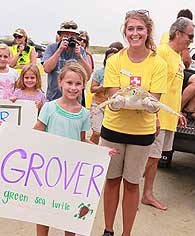 Today, hundreds of people showed up at Kiawah’s Beachwalker County Park to watch the South Carolina Aquarium release two sea turtles, Pier and Grover, back into the sea.
Today, hundreds of people showed up at Kiawah’s Beachwalker County Park to watch the South Carolina Aquarium release two sea turtles, Pier and Grover, back into the sea.
Pier: This juvenile Loggerhead Sea Turtle suffered a massive shark bite to the carapace (shell) and remarkably escaped otherwise unscathed. Luckily, fishermen on the Folly Beach fishing pier caught the injured turtle on hook and line and notified the proper authorities so the turtle could be transported to the Sea Turtle Hospital and returned to optimal health.
Grover: Rescued in March of this year from the chilly waters of Cherry Grove, the juvenile Green Sea Turtle was the first live local stranding of the season. The 60 degree waters caused the turtle to become hypothermic but after 5 months in rehabilitation, is incredibly strong and feisty!
August 16, 2012 ~ Bobcat (Lynx rufus)
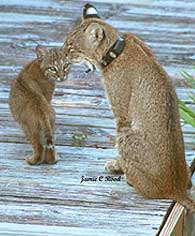 Who says coffee is bad for you? If I wasn’t enjoying my cup this morning outside I never would have seen this Bobcat and her kitten on the boardwalk right in front of the house. It was interesting observing them watch a doe a little further down the boardwalk and then of course watching me. I took several more shots then just the attached so if you are interested in seeing more please check them out on my web site under the bobcat gallery.
Who says coffee is bad for you? If I wasn’t enjoying my cup this morning outside I never would have seen this Bobcat and her kitten on the boardwalk right in front of the house. It was interesting observing them watch a doe a little further down the boardwalk and then of course watching me. I took several more shots then just the attached so if you are interested in seeing more please check them out on my web site under the bobcat gallery.
August 14, 2012 ~ American Alligator (Alligator mississippiensis)
It is with great pleasure to announce the alligator nest at Turtle Point Enclave has hatched. So far 4 hatchlings have been physically seen but there are most likely more! Keep a look out for her to move them possibly to the bridge and please report if you do see them and how many. This is the first week the lakes department has started looking for hatched nests. They will be checking Night Heron gator nest either today or tomorrow.
August 14, 2012 ~ Black Tern (Chlidonias niger)
Town Biologists reported a group of 200-250 Black Terns were seen today on the eastern end of Kiawah’s beach. These early migrating terns are a common sight on Kiawah Island during August each year. They are typically seen roosting on both ends of the island.
August 13, 2012 ~ Prairie Warbler (Setophaga discolor)
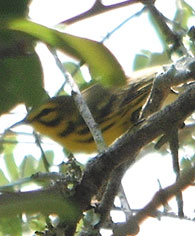 For the past week a Prairie Warbler has been hanging around Mingo Point. Today, Naturalist Brogin Van Skoik was able to spot and photograph it in the salt cedar near the salt marsh margin.
For the past week a Prairie Warbler has been hanging around Mingo Point. Today, Naturalist Brogin Van Skoik was able to spot and photograph it in the salt cedar near the salt marsh margin.
August 12, 2012 ~ Sea Turtles
Looks like the 2012 sea turtle nesting season has come to a close. Preliminary data indicates that a total of 209 sea turtles nested on Kiawah this year.
August 11, 2012 ~ Sea Robin (Prionotus scitulus)
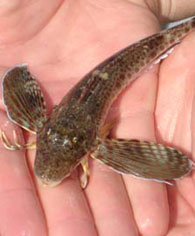 While on a Pluff Mud Kayaking trip, naturalists Kristen and Tyler were cast netting and caught a sea robin. They are bottom-feeders, living at depths of up to 200m (660ft), and mainly stay on the ocean floor. They have large pectoral fins that open and close while swimming, giving them the name sea robin. Sea robins have six spiny “legs”, three on each side, that are used to stir up food while walking on the bottom. They have sharp spines on their gill plates and dorsal fins that inject a mild poison, causing pain for two to three days. Photo Credit: http://www.dnr.sc.gov/ccd/species/pages/searobin2.html
While on a Pluff Mud Kayaking trip, naturalists Kristen and Tyler were cast netting and caught a sea robin. They are bottom-feeders, living at depths of up to 200m (660ft), and mainly stay on the ocean floor. They have large pectoral fins that open and close while swimming, giving them the name sea robin. Sea robins have six spiny “legs”, three on each side, that are used to stir up food while walking on the bottom. They have sharp spines on their gill plates and dorsal fins that inject a mild poison, causing pain for two to three days. Photo Credit: http://www.dnr.sc.gov/ccd/species/pages/searobin2.html
August 10, 2012 ~ Queen Butterfly (Danaus gilippus)
Naturalist Laura Willhoft spotted two Queen Butterflies feeding on Sea Oxeye Daisy on the right side of the path leading to the 9th hole at Ocean Course during the PGA championship.
August 7, 2012 ~ Atlantic Bottlenose Dolphin (Tursiops truncatus)
Kiawah River Field Report from Captain Brad Schmoll: Bottlenose Dolphin mating at the entrance to Oyster Creek.
August 5, 2012 ~ Atlantic Bottlenose Dolphin (Tursiops truncatus)
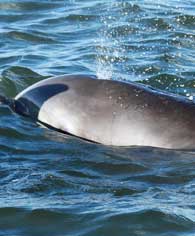
August 3, 2012 ~ Swallow-tail Kite (Elanoides forficatus)
Kiawah Naturalist, Michael Frees spotted a Swallow-tailed Kite flying over the Limehouse Bridge on Johns Island.
Watching the Swallow-tailed Kite is an impressive sight. A striking raptor, with a deep forked tail, this kite can often be seen preforming an aerial ballet. Although the Swallow-tailed Kite is not listed as endangered, it is a rare sight in the lowcountry. The Center of Birds of Prey encourages all sighting to be reported.
August 1, 2012 ~ Sea Turtles
Season to date, Kiawah hosts approximately 207 sea turtle nests.
July 31, 2012 ~ Golden Silk Orbweaver (Nephila clavipes)
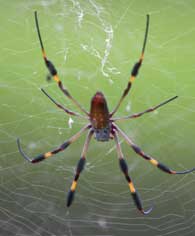 On my gator walks we always walk through the Swamp Garden near the Turtle Point pond. Almost every time I, leading the way, nearly walk right into a huge spider web. Fortunately for the Golden Silk Orbweaver, it has always been just a close call and I have avoided taking down this spider’s intricately designed web.
On my gator walks we always walk through the Swamp Garden near the Turtle Point pond. Almost every time I, leading the way, nearly walk right into a huge spider web. Fortunately for the Golden Silk Orbweaver, it has always been just a close call and I have avoided taking down this spider’s intricately designed web.
Mel Musso, Naturalist
July 30, 2012 ~ Feather Report
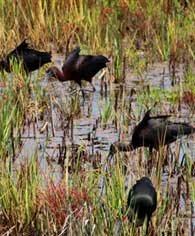 This afternoon, a short walk around Willet pond at the Ocean Course produced a wonderful array of wildlife: Alligators, Anhinga, Belted Kingfisher, Black-crowned Night Herons, Glossy Ibis (14), Great Blue Heron, Great Egrets, Green Heron, Laughing Gulls, Osprey, Rabbit (10th tee), Red-winged Blackbird; Snowy Egrets; tern sp., Tricolor Heron and Wood Storks.
This afternoon, a short walk around Willet pond at the Ocean Course produced a wonderful array of wildlife: Alligators, Anhinga, Belted Kingfisher, Black-crowned Night Herons, Glossy Ibis (14), Great Blue Heron, Great Egrets, Green Heron, Laughing Gulls, Osprey, Rabbit (10th tee), Red-winged Blackbird; Snowy Egrets; tern sp., Tricolor Heron and Wood Storks.
July 27, 2012 ~ Bubblegum Lichen (Icmadophila ericetorum)
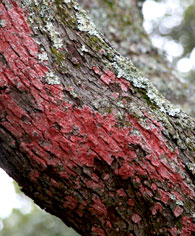 Around Kiawah, Southern Live Oaks, dripping with Spanish Moss, style the iconic beauty of the Lowcountry. As folks cruise the bike path, embracing island life, patches of pink, Bubblegum Lichen speckle the trunks of live oaks like chewing gum affixed to telephone poles of more urban environments. (Check this lichen out near the Nature Center!)
Around Kiawah, Southern Live Oaks, dripping with Spanish Moss, style the iconic beauty of the Lowcountry. As folks cruise the bike path, embracing island life, patches of pink, Bubblegum Lichen speckle the trunks of live oaks like chewing gum affixed to telephone poles of more urban environments. (Check this lichen out near the Nature Center!)
Lichen is both a fungi and algae living together as one in a symbiotic relationship. The fungi provide a structure in which the algae live, whereas the algae supply the fungi with food via photosynthesis in return. The colorful, rosy blobs are known as apothecia; these are the fruiting bodies of lichen where reproduction takes place in the form of spore production. Once the fungal spore is released, it pairs with compatible algal cells to form functional Bubblegum Lichen. Since neither Spanish Moss nor Bubblegum Lichen are parasites, their distinctive presence on the bark of the live oak does not cause any direct harm to the tree.
July 26, 2012 ~ American Alligator (Alligator mississippiensis)
Biologists from the Town of Kiawah and KICA Lakes Department recently completed their annual alligator population survey. During the survey, Biologists counted 138 alligators the first night and 129 the second night. These numbers were averaged and then converted into a population estimate for our survey route using a formula based on pond water temperature. The estimate for 2012 is 365 alligators for the survey route with an estimated island wide population of 500 to 600 alligators.
July 25, 2012 ~ Atlantic Bottlenose Dolphin (Tursiops truncatus)
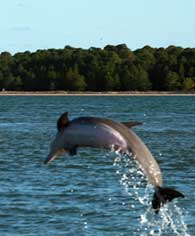
July 24, 2012 ~ Red Knots (Calidris canutus)
This evening on our Family Kayaking, Naturalists spotted a pair of Red Knots in the mudflats behind Kiawah. One the most striking shorebirds, the Red Knots are uncommon on Kiawah this time of year. Typically they spend their summers breeding in the Arctic during the very brief polar summer before making their nearly 10,000 mile migration back to the southern tip of South America.
Matt Arnold, Naturalist
July 24, 2012 ~ Leatherback Sea Turtle (Dermochelys coriacea)
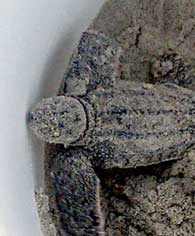 In total of the 87 eggs that were originally laid, the nest evaluation revealed 39 full unhatched eggs, 13 pipped (some turtle formation), 31 hatched, 1 unknown, 21 spacer eggs and 1 live hatchling.
In total of the 87 eggs that were originally laid, the nest evaluation revealed 39 full unhatched eggs, 13 pipped (some turtle formation), 31 hatched, 1 unknown, 21 spacer eggs and 1 live hatchling.
Typically, it is stated Leatherback Sea Turtles have a 60 to 65 day incubation period, meaning that hatchlings emerge from the ground 60 to 65 days after the nest is laid. July 24th marks day 98. We are now excited to change the status of our Leatherback nest to successful!
July 23, 2012 ~ Leatherback Sea Turtle (Dermochelys coriacea)
On April 17th we reported a Leatherback Sea Turtle had nested on Kiawah. On July 9, well past the expected hatch date, Kiawah Turtle Patrol, directed by SCDNR, evaluated the nest. Finding no viable hatchlings, it was determined that development inside the eggs had stopped.
Today, to our amazement, 3 or 4 live hatchlings emerged from the nest. Unfortunately, before Turtle Patrol could react to the news, one hatchling was taken by a crab, another one by a crow.
Tomorrow, Kiawah Turtle Patrol is conducting a second nest evaluation. They will carefully dig up the nest to see if additional hatchlings are buried beneath the sand or if egg development seems to be continuing.
Refer to back to April 17th and July 9th posts for history on this Leatherback Sea Turtle.
July 21, 2012 ~ Belted Kingfisher (Ceryle alcyon)
Captain Mike Frees reported good numbers of dolphin along with many unexpected birds on this morning’s Dolphin Encounters. After a long break from the west end of the Kiawah River, we saw the return of our resident Belted Kingfisher “Kingsley”. Also sighted was an adult Bald Eagle, a Red Knot and increased numbers of marbled godwits. Kingsley, should be with us until early spring when he migrates from Kiawah to breed.
July 20, 2012 ~ 2012 Breeding Bird Point Count Results
 The data has been compiled from the 2012 Breeding Bird Point Count. As part of the Town of Kiawah’s Bird Monitoring Program, 238 points across the island are surveyed annually. From Captain Sam’s Spit in the west to Little Bear Island in the east, points encompass all upland habitat types except for open dunes and beach. The minimum distance between point-count stations is 250 meters in order to reduce the possibility of recording the same bird twice. Each route is conducted in the same order and during the same time period each year.
The data has been compiled from the 2012 Breeding Bird Point Count. As part of the Town of Kiawah’s Bird Monitoring Program, 238 points across the island are surveyed annually. From Captain Sam’s Spit in the west to Little Bear Island in the east, points encompass all upland habitat types except for open dunes and beach. The minimum distance between point-count stations is 250 meters in order to reduce the possibility of recording the same bird twice. Each route is conducted in the same order and during the same time period each year.
For this survey, Town Biologists record all individual birds heard or seen within a 5 minute period. For 2012, a total of 3413 individual birds were counted from 74 different species. The top ten birds for 2012 based on relative abundance are…
1. Carolina Chickadee
2. Northern Cardinal
3. Tufted Titmouse
4. Laughing Gull
5. Carolina Wren
6. Red-winged Blackbird
7. Blue Jay
8. American Crow
9. Great Crested Flycatcher
10. Common Grackle
July 18, 2012 ~ Ocean Seining Field Report
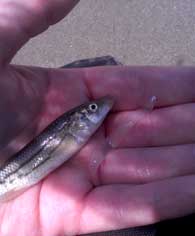 This year’s Ocean Seining have drawn in multiple fascinating and, at times, puzzling finds. Today, an intriguing, tiny, and transparent fish was captured; it was a rare catch amongst the more commonly collected striped killifish (shown below). Research identified the fish as a leptocephalus, which is the primary larval stage in the eel life cycle that exists in oceanic waters. This stage is followed by the glass eel and elver stages of development before maturing into an adult eel. Migration from the sea to fresh, brackish, or estuarine waters corresponds to development progression. Only when adult eels are ready to spawn do they return to the ocean. Little information is known about leptocephali in general; yet, they are unique in comparison to other fish larvae based on not only on appearance but diet too. This sheer, flattened fish has a gelatinous interior that is complete with minuscule organs but lacks red blood cells. Unlike other fish larvae that feast on zooplankton, leptocephali eat “marine snow.” These falling flakes in the water column are composed of detritus and waste material, serving as food for other organisms that live deep in the water column in addition to leptocephali.
This year’s Ocean Seining have drawn in multiple fascinating and, at times, puzzling finds. Today, an intriguing, tiny, and transparent fish was captured; it was a rare catch amongst the more commonly collected striped killifish (shown below). Research identified the fish as a leptocephalus, which is the primary larval stage in the eel life cycle that exists in oceanic waters. This stage is followed by the glass eel and elver stages of development before maturing into an adult eel. Migration from the sea to fresh, brackish, or estuarine waters corresponds to development progression. Only when adult eels are ready to spawn do they return to the ocean. Little information is known about leptocephali in general; yet, they are unique in comparison to other fish larvae based on not only on appearance but diet too. This sheer, flattened fish has a gelatinous interior that is complete with minuscule organs but lacks red blood cells. Unlike other fish larvae that feast on zooplankton, leptocephali eat “marine snow.” These falling flakes in the water column are composed of detritus and waste material, serving as food for other organisms that live deep in the water column in addition to leptocephali.
July 17, 2012 ~ Bobcat (Lynx rufus)
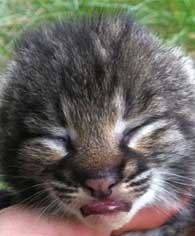 Today, Town Biologists, Jim Jordan and Aaron Given, found their 3rd bobcat den of the season! Bobcat 600 had 1 female kitten in a den on Captain Sam’s Spit. The kitten was 8-9 days old.
Today, Town Biologists, Jim Jordan and Aaron Given, found their 3rd bobcat den of the season! Bobcat 600 had 1 female kitten in a den on Captain Sam’s Spit. The kitten was 8-9 days old.
July 16, 2012 ~ Horseshoe Crab (Limulus polyphemus)
Although Horseshoe Crab sightings along the Kiawah River’s shallow sandy or muddy bottoms are common, Naturalists Matt Arnold and Erin Fannin caught this particular arthropod in a rarely observed act on Captain Sam’s spit. This top heavy creature wound bottoms up in the surf and was attempting to flip herself right side up. To do this, the Horseshoe Crab inserts its telson, or tail, into the sand, providing leverage for the Horseshoe Crab to concavely fold its hinged body over onto itself. Frequently mistaken as an intimidating anatomical structure used for self-defense, the telson is in no way a threatening, stinging barb; it is instead a key feature for steering, balance, and inversion correction.
July 14, 2012 ~ Cicada sp.
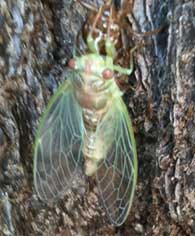 You’ve probably heard these creatures buzzing about the trees throughout the southeast. That sound is comprised of male cicadas calling for a mate. Pictured is one of the many species of annual cicadas that are abundant on Kiawah. It’s not uncommon to find their nymphal exoskeletons clinging to the base of wood structures and trees.
You’ve probably heard these creatures buzzing about the trees throughout the southeast. That sound is comprised of male cicadas calling for a mate. Pictured is one of the many species of annual cicadas that are abundant on Kiawah. It’s not uncommon to find their nymphal exoskeletons clinging to the base of wood structures and trees.
Mike Frees, Naturalist
July 13, 2012 ~ Feather Report
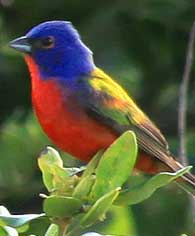
Guide: Brogin Van Skoik
Locations: Mingo Point, Osprey Point, The Preserve, Ocean Course Driving Range/Beach.
Weather: 88, sunny, slight wind…Early Morning, held from 8:30-11:00AM
Highlights: As we walked down to the marsh edge at Mingo Point we were treated to a Clapper Rail bathing in the morning sun. As we left Mingo Point we observed a Painted Bunting singing in all his glory. Through the Preserve we encountered a Red- bellied Woodpecker flying through the canopy as well as a Downy probing for insects. We then stopped at Osprey Point and saw several species feeding throughout the various ponds. These included Osprey, Great Crested Flycatcher, and Eastern Bluebird. Among all the excitement at the Ocean Course we observed a loggerhead shrike feeding near the driving range and calling atop the sculpted oak trees. Success.
Species: Eastern Bluebird, Brown-headed Cowbird, Red-winged Blackbird, Brown Pelican, Double-crested Cormorant, Great Egret, Tricolored Heron, Green Heron, Turkey Vulture, Osprey, Clapper Rail, Mourning Dove, Red-bellied Woodpecker, Downy Woodpecker, Great Crested Flycatcher, Loggerhead Shrike, American Crow, Fish Crow, Carolina Chickadee, Northern Mockingbird, Northern Cardinal, Painted Bunting, Wood Stork.
July 12, 2012 ~ Loggerhead Sea Turtle (Caretta caretta)
First Loggerhead Sea Turtle nest of the season has hatched!
July 10, 2012 ~ Bobcat (Lynx rufus)
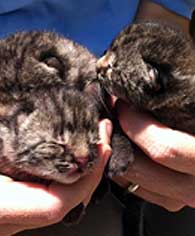 Town Biologists have found another bobcat den! Bobcat 300 (“McKenzie”) had 3 male kittens in a den along Ocean Course Drive. The kittens were 5-6 days old.
Town Biologists have found another bobcat den! Bobcat 300 (“McKenzie”) had 3 male kittens in a den along Ocean Course Drive. The kittens were 5-6 days old.
Over the last few years Town Biologists have been focusing their research on female bobcats in order to try to better understand their habitat needs during the denning time period. They are also trying to determine survival rates of kittens. Once a bobcat den is located, Biologist will age, weigh and sex the kittens. Each kitten also receives a tiny PIT(Passive Integrated Transponder) tag. This allows biologists to positively identify the kitten if they catch it in future years or it gets hit and killed by a car. Jim Jordan, our Town Biologists says, “it has been very enlightening to catch bobcats as adults and be able to know where and when they were born and who the mother was.”
July 9, 2012 ~ Leatherback Sea Turtle (Dermochelys coriacea)
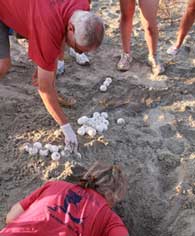 After a long wait, the excitement of Kiawah’s Leatherback Sea Turtle nest has come to an end. For the past several weeks, the Nature Center was in quite a buzz with this being only the second Leatherback nest on Kiawah in recent memory. But after the anticipated hatch date came and went, SCDNR gave the Kiawah Turtle Patrol permission to evaluate the nest. This morning the Turtle Patrol began carefully digging into the nest site. Often during a typical sea turtle nest evaluation, hatchlings or viable eggs are uncovered; sadly, that was not the case here. Although it was clear that the eggs were fertilized and hatchling development has occurred, at some point development stopped. Our best guess is that the highly variable spring temperatures we experienced negatively impacted the hatchling development.
After a long wait, the excitement of Kiawah’s Leatherback Sea Turtle nest has come to an end. For the past several weeks, the Nature Center was in quite a buzz with this being only the second Leatherback nest on Kiawah in recent memory. But after the anticipated hatch date came and went, SCDNR gave the Kiawah Turtle Patrol permission to evaluate the nest. This morning the Turtle Patrol began carefully digging into the nest site. Often during a typical sea turtle nest evaluation, hatchlings or viable eggs are uncovered; sadly, that was not the case here. Although it was clear that the eggs were fertilized and hatchling development has occurred, at some point development stopped. Our best guess is that the highly variable spring temperatures we experienced negatively impacted the hatchling development.
July 3, 2012 ~ Horseshoe Crab (Limulus polyphemus)
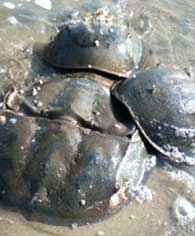 Our Jr. Naturalist Marsh Ecology trip began with an up close and personal look at three horseshoe crabs engaged in an ancient mating ritual with two males and the much larger female. Females release a pheromone into the water to attract the awaiting males. She will then drag a male to the surface. When all is “said” and done, she deposits 5-7 clumps of 2000-4000 eggs each, or up to 20,000 eggs in a spawning episode. It is estimated that less than ten of these eggs will survive to adulthood. The horseshoe crab is currently listed as Near Threatened (IUCN 2.3). The loggerhead sea turtle has suffered from the reduction in numbers of this amazing creature. Please visit http://horseshoecrab.org/ for more information.
Our Jr. Naturalist Marsh Ecology trip began with an up close and personal look at three horseshoe crabs engaged in an ancient mating ritual with two males and the much larger female. Females release a pheromone into the water to attract the awaiting males. She will then drag a male to the surface. When all is “said” and done, she deposits 5-7 clumps of 2000-4000 eggs each, or up to 20,000 eggs in a spawning episode. It is estimated that less than ten of these eggs will survive to adulthood. The horseshoe crab is currently listed as Near Threatened (IUCN 2.3). The loggerhead sea turtle has suffered from the reduction in numbers of this amazing creature. Please visit http://horseshoecrab.org/ for more information.
Brad Schmoll, Naturalist
July 2, 2012 ~ Osprey (Pandion haliaetus)
 Throughout the island, high up in the canopy, Kiawah’s ospreys are diligently tending to their young. At our Sanctuary nest, located in the far end of the eastern parking lot, this juvenile osprey has left the nest to explore nearby branches. Over the next few days we will observe him stretching his wings as he learns to fly.
Throughout the island, high up in the canopy, Kiawah’s ospreys are diligently tending to their young. At our Sanctuary nest, located in the far end of the eastern parking lot, this juvenile osprey has left the nest to explore nearby branches. Over the next few days we will observe him stretching his wings as he learns to fly.
Photo taken by Jamie Rood on her Nature Photography class
July 1, 2012 ~ American Alligator (Alligator mississippiensis)
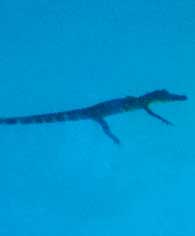 Three foot alligator found early this morning cooling off in the Night Heron Park Pool
Three foot alligator found early this morning cooling off in the Night Heron Park Pool
Gavian Gregory, KIGR Pool Manager
June 30, 2012 ~ Bobcat (Lynx rufus)
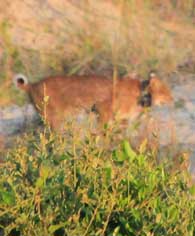 Thanks to the calling alarm from the crows, I was able to locate this bobcat making her way thru the dunes off Surfsong Road. Not the best shot it was pretty far away and late in the evening but a bobcat is always worth a shot!
Thanks to the calling alarm from the crows, I was able to locate this bobcat making her way thru the dunes off Surfsong Road. Not the best shot it was pretty far away and late in the evening but a bobcat is always worth a shot!
Jamie Rood, Staff Photographer
June 28, 2012 ~ Loggerhead Shrike (Lanius ludovicianus)
In the past month Naturalists have been observing consistent citings of a pair of Loggerhead Shrikes on the southwest corner of Andell Island. While the nest itself has not yet been located, overt nesting behavior has been displayed by the pair.
Matt Arnold, Naturalist
June 27, 2012 ~ Sea Turtles
Kiawah currently hosts 131 sea turtle nests, 128 Loggerhead, 1 Leatherback and 2 possible Green turtles.
June 26, 2012 ~ American Alligator (Alligator mississippiensis)
On my 4:30 pm Alligator Adventure the group came across alligator cannibalism at Osprey Point Pond. We heard some rustling by the edge of the water on the side before you hit the bridge. As the group went to investigate, a large 10-12 ft gator was spotted with a smaller 4-6 ft alligator in his mouth. As we approached to get a closer look, the gator backed away with his dinner and swam away. Curious, I researched this topic later and found out that cannibalism is not an uncommon behavior for alligators especially for larger individuals in areas with high population density like at Osprey Point.
Melanie Musso, Naturalist
June 24, 2012 ~ Loggerhead Shrike (Lanius ludovicianus)
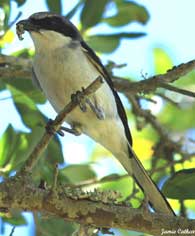
Through causal observations, it seems that Loggerhead Shrike sightings have become increasingly rare on Kiawah over the past 20 years. This however, is not surprising since this once abundant species has declined drastically throughout its entire range. Listed as one of “Audubon’s Common Bird in Decline”, the Loggerhead Shrike has seen its population drop 72% since 1967. Although the reasons for the decline are not well understood, scientists believe it is correlated to the loss of grassland habitat.
Over the past few weeks, this individual shrike has been consistently sighted at the Ocean Course on Kiawah Island. It is our hope that shrikes and other grassland birds will continue to benefit from the habitat that the Ocean Course provides.
June 19, 2012 ~ Feather Report
Guide: Brogin Van Skoik
Tour: Back Island Birding
Locations: Mingo Point, Bull Thistle Pond, Ocean Course Driving Range/Beach, Turtle Pond.
Weather: 85, sunny, little wind…Early Morning, held from 8-11:00AM
Highlights: We walked briefly through the park and saw the Eastern Bluebird and Red-bellied Woodpecker. We then headed to Mingo point where we saw the egrets and herons. We heard the Yellow-throated Warbler and Painted Bunting but they decided not to make an appearance. As we were leaving Mingo we saw a Brown-headed Nuthatch clambering along the branches in back of the shack. Are next stop was Bull Thistle Pond where we stalked a Black-necked stilt until he saw us and took off. While we were observing the stilt, a Wood Stork was soaring over head so we watched until the bugs got bad. The second to last stop was the Ocean course/Driving Range, there we saw the infamous Butcher bird, AKA the Loggerhead Shrike. We found the nest and observed both male and female guarding and incubating the nest. Over all it was a success.
Species: Eastern Bluebird, Brown-headed Cowbird, Brown-headed Nuthatch, Red-winged Blackbird, House Finch, Brown Pelican, Double-crested Cormorant ,Great Egret, Snowy Egret, Tricolored Heron, Green Heron, Turkey Vulture, Osprey, Clapper Rail, Mourning Dove, Red-bellied Woodpecker, Downy Woodpecker, Loggerhead Shrike, American Crow, Fish Crow, Carolina Chickadee, Northern Mockingbird, Northern Cardinal, Boat-tailed Grackle, Black-necked Stilt, Wood Stork.
June 17, 2012 ~ Gray Fox (Urocyon cinereoargenteus floridanus)
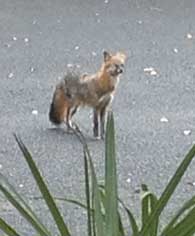
Gray foxes, one of the smallest members of the dog family, typically weigh between 7-10 pounds. They are omnivorous, opportunistic feeders; eating a variety of plants and animals; including rabbits, rodents, fruits, insects, berries and acorns.
Interestingly, the Gray Fox is the only member of the dog family that can readily climb trees, which it does to escape predators or find food.
June 16, 2012 ~ Sand Tiger Shark (Carcharias taurus)
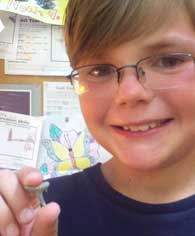 Kiawah is known for many wildlife treasures, sharks teeth are NOT one of them! So naturalists were especially excited when 11 year old Brennan from Georgia came into the Heron Park Nature Center with a tooth. A perfect specimen, Brennan found the tooth on the front beach not far from Night Heron Park. Naturalists identified the tooth as a Sand Tiger Shark (Carcharias taurus).
Kiawah is known for many wildlife treasures, sharks teeth are NOT one of them! So naturalists were especially excited when 11 year old Brennan from Georgia came into the Heron Park Nature Center with a tooth. A perfect specimen, Brennan found the tooth on the front beach not far from Night Heron Park. Naturalists identified the tooth as a Sand Tiger Shark (Carcharias taurus).
A large shark, Sand Tigers, range from 6.5 to 10 feet in length. They are ferocious in appearance, given their large mouth with a huge number of these impressive teeth protruding in all directions (44-48 teeth in the upper jaw; 41-46 in the lower jaw). But appearances are deceiving, Sand Tigers are in fact timid, docile and non-aggressive; feeding on small fish, crustaceans and squid.
We would like to thank Brennan for sharing his treasure with us.
June 15, 2012 ~ Florida Manatee (Trichechus manatus latirostris)
Captain John Ward and his fishing crew spotted a large manatee near the Kiawah Island Bridge.
June 14, 2012 ~ Great Egret (Ardea alba)
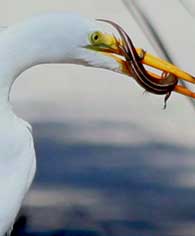 Great Egret snacking on a lizard. Highlight from today’s Nature Photography tour with Jamie Rood.
Great Egret snacking on a lizard. Highlight from today’s Nature Photography tour with Jamie Rood.
June 14, 2012 ~ Cannonball Jellyfish (Stomolophus meleagris)
 During this time of year, Stomolophus meleagris, commonly known as the cannonball jellyfish, comprises approximately 16% of inshore biomass and may be seen either washed up on the sand or swimming along the shoreline.
During this time of year, Stomolophus meleagris, commonly known as the cannonball jellyfish, comprises approximately 16% of inshore biomass and may be seen either washed up on the sand or swimming along the shoreline.
While most people are familiar with the “typical” jellyfish adorned with long tentacles and painful stinging cells, Cannonball Jellyfish are different. Below the cannonball’s bell hangs a firm, gristle-like feeding apparatus which is used to remove plankton from the water. Due to the fact that these jellies feed almost exclusively on plankton, tentacles and sting cells are not required for feeding. Also, unlike other jellyfish, Cannonball Jellies are superb swimmers and it is not unusual to see a spider crab hitching a ride.
Cannonball jellies are a sea turtles’ favorite food. Therefore, it is important to keep our shores artificial jellyfish (plastic bag) free!
June 13, 2012 ~ Fin and Feather Report
“Thumbs up”, one of our resident female dolphin, and her crew (2 other dolphin) were very busy strand feeding at Captain Sam’s Inlet and at the entrance to the creek by Long Island on Seabrook. Brown Pelicans, Black Skimmers, Caspian, and Least Terns were in full force. We counted 16 American Oyster Catchers on the sandy mud bar across from the Inlet Cove Dock. At the conclusion of the trip, we saw four Wood Storks circling and eventually landing in a creek in the Beachwalker Park area.
Reported by Captain Brad Schmoll
June 12, 2012 ~ Raccoon (Procyon loto)
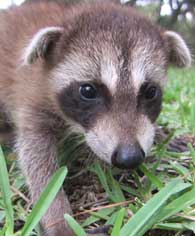
Although ones first instinct might be to take in such a young raccoon, we know that a lone animal does not necessarily mean it’s an orphaned animal. With nocturnal animals like raccoons, it is common for members of a litter to stray from the mother while she sleeps during the day. In fact, raccoons do not become nocturnal until they are approximately one year old.
Carefully picking up the kit, we placed her in a close but protective area. If the mother is going to find her baby, she will do it within the next several hours. First thing Tuesday morning, we headed out to the Preserve and with great pleasure our little kit was nowhere in sight. Special thanks to Mr. Blake who took the time to call the Nature Center, he certainly saved this little one’s life.
June 12, 2012 ~ Reddish Egret (Egretta rufescens)
Town Biologists report a Reddish Egret was seen on the east end of Kiawah’s beach today. This is the first Reddish Egret we have seen this year. These birds are uncommon summertime visitors to the island and we typically see 3-4 per year on Kiawah’s beach, typically on the extreme east and west ends of the island. Reddish Egrets are very active when feeding and are often seen running and flapping their wings as they chase small baitfish and shrimp in tidal pools.
June 11, 2012 ~ Loggerhead Sea Turtle (Caretta caretta)
 On our Shark Fishing charter, Captain John Ward’s group had an unexpected catch! This adult, female Loggerhead Sea Turtle took a whole, live mullet off the line. Thanks to Captain Ward’s quick thinking, the hook was safely removed and the turtle swam away.
On our Shark Fishing charter, Captain John Ward’s group had an unexpected catch! This adult, female Loggerhead Sea Turtle took a whole, live mullet off the line. Thanks to Captain Ward’s quick thinking, the hook was safely removed and the turtle swam away.
June 9, 2012 ~ Mississippi Kite (Ictinia mississippiensis)
Our Wildlife in the Wetlands biking tour proved to be successful, once again. The Bass Pond area was vibrant with Snowy Egrets, Tricolored Herons, Willets and a lone Wood Stork feeding in the distance. After seeing this, we made our way back to the parkway and headed east from the Vanderhorst gate towards Marsh Island Park. We made a stop at a pond to view a very large Yellow Bellied Slider sunning itself next to a ~5 foot alligator. Above us, a Mississippi Kite was gliding gracefully, in a kind of figure eight pattern, for about 20 seconds. Although present on Kiawah this time of the year, we don’t regularly see Mississippi Kites, which made this particular moment very special. This medium sized raptor has a grayish white color with scarlet eyes. It feeds primarily on large insects and will also take lizards and frogs. Had it not been for its distinctive “phee-phew” call, we probably would have not bothered to look up, at that moment, to notice that he was just a hundred feet above our heads.
June 8, 2012 ~ Bald Eagle (Haliaeetus leucocephalus)
Today, on a Family Kayaking excursion, Naturalist Matt Arnold spotted a Bald Eagle in the salt marsh between Kiawah and Seabrook.
June 7, 2012 ~ American Alligator (Alligator mississippiensis)
 Female Alligator at Night Heron Park protecting her nest.
Female Alligator at Night Heron Park protecting her nest.
June 6, 2012 ~ Whelks (Busycon sp.)
To date, two named tropical storms have formed off our coast creating high surf, turbulent wave action and tropical bands of thunderstorms. After Beryl, the latter of these storms, I was excited to see tons of marine life washed up on Kiawah’s beach. I have never seen so many mermaids’ necklaces (whelk egg cases) scattered on the beach. There are four species of predatory whelk snail (many guests accidently call conchs), that are native to our coastal region (knobbed, channeled, lightening and pear). These female snails produce a long coiled casing that holds developing fertilized eggs. Each circular capsule contains around 20 eggs that develop surrounded by a nutritious gel-like substance. This casing is anchored down into the sand or glued to some hard substrate so that it does not wash up and dehydrate; the casing also serves as protection from larger predators. However, because of Beryl, strong waves pulled up many of these egg cases and pushed them up on our beach for curious beachcombers to inspect. A closer examination of the egg case might show small holes in the top of each capsule, areas where fully developed miniature snails have chewed their way to freedom in the water column. Here, they will continue their development in the waters of our coastal ecosystem.
June 5, 2012 ~ Wild Turkey (Meleagris gallopavo)
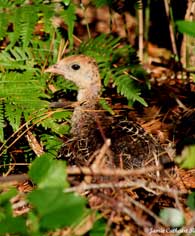
June 1, 2012 ~ Feather Report
Birds sighted today on Back Island Birding with Naturalist, Brogin Van Skoik.
Eastern Bluebird, Osprey, Carolina Chickadee, Tufted Titmouse, Northern Cardinal, Black Skimmer, Marsh Wren, Brown Pelican, Laughing Gull, Red-winged Blackbird, Boat-tailed Grackle, Yellow-throated Warbler, Green Heron, Common Moorhen, Great Egret, Painted Bunting, Loggerhead Shrike, Tricolored Heron, Black-necked Stilt, Brown Thrasher, European Starling, Anhinga, Double-crested Cormorant.
May 31, 2012 ~ Loggerhead Sea Turtle (Caretta caretta)
Season to date, Kiawah hosts 51 sea turtle nests (1 leatherback and 50 loggerhead).
May 30, 2012 ~ White-tailed Deer (Odocoileus virginianus)
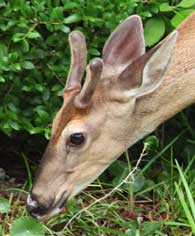
By August, antler growth slows and they begin to harden. In late August or early September, growth is completed and blood ceases to flow to the antlers. The drying velvet sheds off or is rubbed off by rubbing the antlers against woody vegetation. Velvet shedding is quick, usually occurring in less than 24 hours. The result is hard polished alters for the breading season.
May 28, 2012 ~ Bonnethead Shark (Sphyrna tiburo)
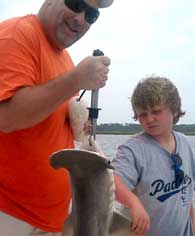 Phenomenal day for Shark Fishing on Kiawah! Captain Mike’s crew simultaneously boated 3 sharks. While folks on Captain John’s boat caught a Bonnethead Shark 1lb short of the world record (world record 26lbs 0oz, Florida 2006)…as always all sharks were safely release back into the marsh.
Phenomenal day for Shark Fishing on Kiawah! Captain Mike’s crew simultaneously boated 3 sharks. While folks on Captain John’s boat caught a Bonnethead Shark 1lb short of the world record (world record 26lbs 0oz, Florida 2006)…as always all sharks were safely release back into the marsh.
May 25, 2012 ~ Loggerhead Sea Turtle (Caretta caretta)
As of today, there are 39 sea turtle nests on Kiawah. When reviewing the Kiawah Turtle Patrol’s daily nest counts dating back to 1999, this is the highest number of nests season to date.
May 25, 2012 ~ Florida Manatee (Trichechus manatus latirostris)
Tim & Teresa Myrick spotted a manatee surface at Captain Sam’s Inlet around 10 am this morning.
May 24, 2012 ~ Fin Report
Sunset Cruise Fin Report by Captain Jake Feary: At nearly high tide, we observed 3 distinct groups of Bottlenose Dolphin in the Kiawah River between Beachwalker County Park and the 1st Seabrook dock. First, was one juvenile on its own, most likely male. Second, was a mother and her pup. The mother was strand feeding on her own and was very explosive. She seemed to be going after single large mullet and was very precise with her moves. I don’t think she was teaching as she was way ahead of pup and pup was seemingly just trying to catch up to mom. It was very entertaining to watch the young one swim as fast as possibly near the surface…almost completely breaching every other or 3rd tail pump. The third group was comprise of two adults, one of which was marked with an unreadable dorsal number. Both stuck together and seemed to just be out for an evening stroll. No feeding, just cruising the bank into Oyster Creek.
May 22, 2012 ~ Barn Swallow (Hirundo rustica)
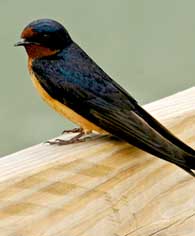
May 18, 2012 ~ Black-necked Stilt (Himantopus mexicanus)
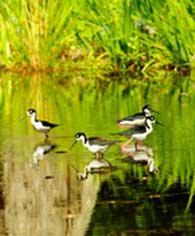
Select wetlands on Kiawah only maintain water during significant rain or unusually high tides. Last weekend, the nearly 8 foot tides caused by the super moon flooded this wetland on Bull Thistle Lane. The water revitalized a plethora of invertebrates that otherwise seek sanctuary buried in the mud….Then the birds came to feed! Among the most unusual, a flock of Black-neck Stills and Glossy Ibis.
May 16, 2012 ~ Loggerhead Sea Turtle (Caretta caretta)
Kiawah’s beach now has 13 sea turtle nests: 1 leatherback and 12 loggerhead. 2002 was the only year with more nests on May 15th (with 27). If you are interested in a comparison between 2012 and previous years, visit KiawahTurtles.com.
May 15, 2012 ~ Feather Report
Feather Report from Back Island Birding with Naturalist, Matthew Arnold: Painted Bunting 3 (1 male and 1 female banded); Red-tailed Hawk 1; Great Crested Flycatcher 1; Marsh Wren 1; Black Skimmer 2; Snowy Egret 1; Great Egret 4; Brown-headed Nuthatch 1; Cowbird X; Clapper Rail 1; Carolina Chickadee X; Fish Crow 3; American Crow X; Carolina Wren 2; Tri-colored Heron 1; Common Moorhen 2 (~6 chicks); Osprey 2; Woodstork 1; Barn Swallow 10; Eastern Bluebird 2; Brown Eastern Brown Pelican 2; Mourning Dove X; Glossy Ibis 3; Black-necked Stilt 5
X=undermined number of individuals
May 14, 2012 ~ Rose-breasted Grosbeak (Pheucticus ludovicianus)
Rose-breasted Grosbeak reported by Naturalist Brad Schmoll at Mingo Point.
May 12, 2012 ~ Common Moorhen (Gallinula chloropus)
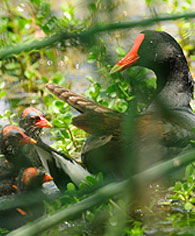
May 10, 2012 ~ Green Heron (Butorides virescens)
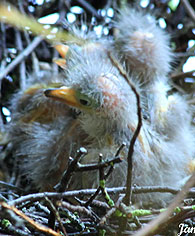
May 9, 2012 ~ Loggerhead Sea Turtle (Caretta caretta)
First Loggerhead Sea Turtle nest of the 2012 season.
May 6, 2012 ~ White-tailed Deer (Odocoileus virginianus)
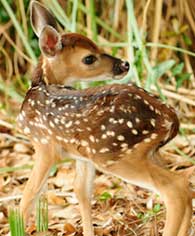
If you encounter a fawn lying by itself, do not approach or touch it. Any interaction with humans greatly increases the chances of the fawn being killed or injured. The female will return periodically to feed and check on the fawn.
Fun Fact: The white spots on the fawn are camouflage, simulating sunspots, which make their way through the trees.
May 5, 2012 ~ Common Moorhen (Gallinula chloropus)
Common Moorhen nest on the northeast corner of the Enclave at Turtle Point has hatched. We are only able to get a fleeting glimpse of 2 hatchlings as the parents are keeping them well protected in the dense vegetation on the pond edge.
May 1, 2012 ~ Monarch (Danaus plexippus)
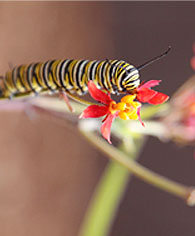
April 26, 2012 ~Wild Turkey (Meleagris gallopavo)
 Wild Turkey nest found on the Cassique Golf Course.
Wild Turkey nest found on the Cassique Golf Course.
April 24, 2012 ~ Black Racer (Coluber constrictor)
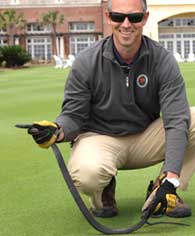 A Black Racer hiding under banquet tables on the Sanctuary Grand Lawn was captured by our Director of Landscaping, Philip Zellner. After a quick examination, she was carefully relocated into the nearby scrub thicket, where she could continue to do her part in keeping Kiawah’s ecosystem in balance.
A Black Racer hiding under banquet tables on the Sanctuary Grand Lawn was captured by our Director of Landscaping, Philip Zellner. After a quick examination, she was carefully relocated into the nearby scrub thicket, where she could continue to do her part in keeping Kiawah’s ecosystem in balance.
In the Southeast, generally speaking there are two species of “black snakes”: Black Racers (Coluber constrictor) and Black Rat Snakes (Elaphe obsoleta obsoleta). Both species are non-venomous, slender black snakes that can reach 5+ feet in length. So how do you distinguish one from the other?
When observed from a distance, behavior is often the best way to differentiate between the species. Black Racers are fast! When approached they often vanish with great speed, hence the name racer. Black Rat Snakes, on the other hand, are slow, and at times remain motionless when approached.
Black Racers are a dull black color with a bright white chin. Black Rat Snakes also have a white chin but tend to be a shinier black; some individuals may even have light traces of a blotched pattern on their backs. Racers are active prowlers; adept at climbing, they often ascend shrubs and low tree limbs feeding on a wide variety of prey including insects, lizards, snakes, birds, rodents, and amphibians. Black Rat Snakes are awesome climbers, frequently climbing up the side of a building or straight up the trunk of an oak tree searching for birds, bird eggs or small mammals to prey upon. Whether talking about the Black Racer or Black Rat Snake; both play a vital role in the food web.
The Black Rat Snake is widely distributed ranging from New England south through Georgia and west across the northern parts of Alabama, Mississippi, and Louisiana. On Kiawah however, we are just outside of the range for the Black Rat Snake. So if you encounter a long slender uniformly black snake, high probability you are looking a Black Racer. In fact on Kiawah, Black Racers were listed as a “high frequency” species on a recent herpetology study conducted by Keith Hanson from College of Charleston.
April 17, 2012 ~ Leatherback Sea Turtle (Dermochelys coriacea)
 During the very early hours of April 17th, an enormous female Leatherback Sea Turtle made her way onto Kiawah’s beach front to lay her eggs. Bringing some history along with her, this is the first sea turtle nest in South Carolina for the 2012 nesting season and only the second known leatherback nest on our island.
During the very early hours of April 17th, an enormous female Leatherback Sea Turtle made her way onto Kiawah’s beach front to lay her eggs. Bringing some history along with her, this is the first sea turtle nest in South Carolina for the 2012 nesting season and only the second known leatherback nest on our island.
The track width of our female was 5’11” from flipper to flipper, not surprising since these endangered turtles are among the largest reptiles in the world, commonly exceeding 1,000 pounds. An evaluation by South Carolina Department of Natural Resources revealed 87 billiard-ball size eggs and 47 smaller spacer eggs. Spacer eggs, characteristic of leatherback nests, have no yolk just a clear liquid. Scientists are unclear on the exact function of the spacer eggs.
Since Kiawah Island Turtle Patrol began keeping records in the 1980’s, this is only the second Leatherback Sea Turtle nest on Kiawah. According to SCDNR there have been an increasing number of these turtles in our coastal waters since the 1980’s. The highest numbers occur in the spring when they are feeding on our abundant cannonball jellyfish.
Nesting of Leatherbacks occurs between March and July, so our female is within the typical nesting season. With an incubation time of 60 to 65 days, we expect the nest to hatch in mid-June. Like most species of sea turtles, a single female leatherback will lay several clutches within the season. Leatherback clutches are typically laid 9 to 10 days apart and frequently in fairly close proximity to her other nests. Could this mean Charleston County will have a 2nd Leatherback nest before the end of the month?
April 13, 2012 ~ American Mink (Neovison vison)
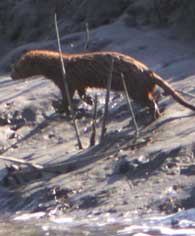 A rare sight on Kiawah….Naturalist Mike Frees was able to capture these photos of a mink on his kayaking excursion.
A rare sight on Kiawah….Naturalist Mike Frees was able to capture these photos of a mink on his kayaking excursion.
These weasel-like mammals have a long slender body, dark brown fur, short legs and partially webbed feet. Mink are voracious predators feeding on a large variety of animals, including: crabs, snakes, fish, birds, clams, rats, and mice.
April 11, 2012 ~ Cedar Waxwing (Bombycilla cedrorum)
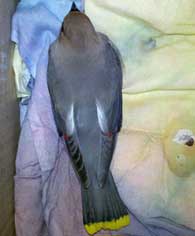 An adult Cedar Waxwing was spotted in Night Heron Park, and appeared to be a little dazed. Luckily one of Kamp Kiawah counselors, Jordan Pierce, was able to get it safely in a box and bring inside the Nature Center. After a night of R & R inside the center, the bird was happily released and flew away.
An adult Cedar Waxwing was spotted in Night Heron Park, and appeared to be a little dazed. Luckily one of Kamp Kiawah counselors, Jordan Pierce, was able to get it safely in a box and bring inside the Nature Center. After a night of R & R inside the center, the bird was happily released and flew away.
April 6, 2012 ~ Feather Report
Four Glossy Ibis and two Black-necked Stilts at Willet Pond
April 4, 2012 ~ Florida Manatee (Trichechus manatus latirostris)
First of the season manatee sighting on Kiawah. The individual was reported by a group on Captain Mike Waller’s fishing charter near the Rhett’s Bluff section of Kiawah. This sighting is significantly earlier than past years, perhaps do to the warmer spring. SCDNR reports manatees frequent South Carolina rivers and estuaries in which the water temperature is at least 68 degrees fahrenheit.
April 3, 2012 ~ Loggerhead Shrike (Lanius ludovicianus)
During this afternoon’s Family Kayaking, Naturalist Mike Frees spotted a Loggerhead Shrike perching on a dead tree behind Cassique Golf Course. These interesting birds are also known as Butcherbirds or French Mockingbirds.
April 1, 2012 ~ Painted Bunting (Passerina ciris)
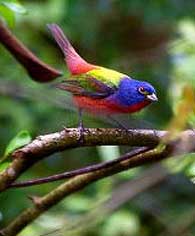
April 1, 2012 ~ Fin and Feather Report
Dolphin activity in the Kiawah River was very good today. With the exception of the first trip, we saw dolphin on all trips. However, we did not see any strand feeding today. As usual, birds were also out in “full force”, particularly at Captain Sam’s inlet. Along with the usual suspects, Caspian and Royal Terns were relatively abundant; Osprey were successfully feeding, and the Brown Pelicans seemed to be everywhere! The Black Skimmers were clearly the favorite species for our guests today. It is really good to have them back.
March 31, 2012 ~ Wilson’s Plover (Charadrius wilsonia)
Nesting behavior has been observed among our Wilson’s Plovers!
Shorebirds like Wilson’s Plovers, Least Terns, Black Skimmers and American Oystercatchers historically nest either on the west end of the island near Captain Sam’s Inlet or on the east end adjacent to the Ocean Course Driving Range.
Nesting shorebirds are particularly sensitive to human disturbance since environmental conditions on the beach are already harsh and unpredictable. Any disturbance by people, pets or bicycles can cause shorebirds to temporarily or permanently abandon their nests. Unprotected eggs or chicks can quickly succumb to the hot sun or predation by gulls and crows. Even one dog passing near a colony of nesting shore birds can cause all the birds to panic, leaving their nests dangerously exposed.
How you can help protect beach-nesting birds:
1. Town Biologists have posted signs in the nesting areas. Never enter these posted areas.
2. Keep dogs on a leash and away from areas where birds may be nesting.
3. Properly dispose of trash.
4. When birds are aggravated, you are too close.
Spread the news…Pass it on! Learn more.
March 28, 2012 ~ Robin or Cecropia Moth (Hyalophora cecropia)
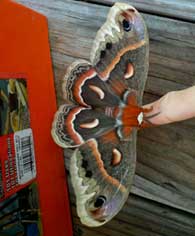 After receiving a call from a John’s Island resident, I stopped by to pick up a what was described as a large butterfly he had found that was having trouble flying. Once I got there I was pleased to discover it was a Cecropia Moth (Identified by one of our other naturalists, Mike Frees) or commonly called Robin Moths. They are North America’s largest moth and usually found at night. As you can see they are a very colorful unique moth, and I was happy to see it fly off to continue it’s life cycle.
After receiving a call from a John’s Island resident, I stopped by to pick up a what was described as a large butterfly he had found that was having trouble flying. Once I got there I was pleased to discover it was a Cecropia Moth (Identified by one of our other naturalists, Mike Frees) or commonly called Robin Moths. They are North America’s largest moth and usually found at night. As you can see they are a very colorful unique moth, and I was happy to see it fly off to continue it’s life cycle.
Nick Boehm, Naturalist
March 24, 2012 ~ Snowy Egret (Egretta thula)
We got a call from one of our Motorboat captains/Naturalists, Bradley Schmoll, about a bird near Inlet Cove dock that appeared to be in distress. Once we went to investigate we found, to our surprise, a Snowy Egret that had a clam closed up on one of it’s toes, and was large enough to weigh the bird down so it could not fly. After carefully retriving the bird from the spartina grass we brought it back to our dock were naturalists Matthew Arnold held the egret and Brogin Van Skoik popped open the clam. Once free we put it back in the marsh, and will hope for a full recovery.
March 23, 2012 ~ Black-necked Stilt (Himantopus mexicanus) .
First Black-neck Stilts of the season were reported by Naturalists Jamie Rood and Liz King. The birds were located in a tidal pond on the western end of Kiawah.
March 23, 2012 ~ Sandhill Crane (Grus canadensis) * first record on Kiawah
Today while banding marsh sparrows, Town Biologists observed a Sandhill Crane in the marsh. The first ever recorded on Kiawah. It fed in the marsh along the Kiawah River for a while and flew off across the river toward John’s Island
March 18, 2012 ~ American Crow (Corvus brachyrhynchos)
I was cleaning up after a family kayak tour, and was scanning the surroundings for any birds soaring in the air, when i turned to my left, I saw an American Crow perched on the weather vane with a cardinal at his feet. As I looked at him he began squawk and proceeded to pick at the cardinal. This is one of those rare moments in nature that catches your eye and makes you wonder what happen? How did this Crow catch a cardinal? Looking back on the moment, I remember thinking about how tragic it was that this beautiful cardinal had its life taken from it by this dark shadow the Crow, but that is why nature is so fascinating. Nature’s beauty always has a dark side.
Brogin Van Skoik, Naturalist
March 17, 2012 ~ Yellow-headed Blackbird (Xanthocephalus xanthocephalus) * first record on Kiawah
This weekend at Mingo Point, Naturalists Mike Frees and Matt Arnold witnessed a male Yellow-headed Blackbird at our bird feeder. The male with its black body and bright yellow head is unmistakable.
Outside its characteristic range, the Yellow-headed Blackbird winters in the southwestern U.S. and central Mexico. During spring migration they typically migrate in large flocks that are segregated by sex and age. The YHB settles to breed in the prairie and mountain meadow wetlands of the western and central U.S. and Canada. However, according to Cornell Ornithology, nearly every winter a few Yellow-headed Blackbirds appear along the East Coast, especially in Florida.
An exciting new species for Kiawah! We will keep you updated if there are any future sightings.
March 16, 2012 ~ Red Knots (Calidris canutus)
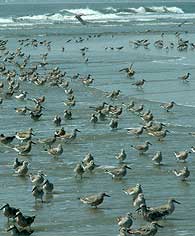 Today, Town Biologist conducted a beach survey and estimated 8000 Red Knots on our front beach. That represents approximately 30% of the Red Knot population in our flyway.
Today, Town Biologist conducted a beach survey and estimated 8000 Red Knots on our front beach. That represents approximately 30% of the Red Knot population in our flyway.
March 14, 2012 ~ American Alligator (Alligator mississippiensis)
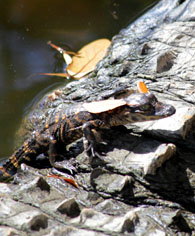 If you’ve been following us for a while, you are familiar with our resident female gator at Night Heron Park. Last May, we were treated to some phenomenal mating displays. June came and she carefully constructed her nest, the same location as the past three years. Then mid-August, we patiently waited by our bridge for the first glimpse of her hatchlings…but nothing!
If you’ve been following us for a while, you are familiar with our resident female gator at Night Heron Park. Last May, we were treated to some phenomenal mating displays. June came and she carefully constructed her nest, the same location as the past three years. Then mid-August, we patiently waited by our bridge for the first glimpse of her hatchlings…but nothing!
After several weeks of no hatchling, our naturalists went into the brush to evaluate the nest. The shells of three eggs lay torn atop the pile of vegetation that was her nest. Looking into the surrounding water, still no hatchling could be found. Into early fall with still no hatchlings, we came to the sad realization that the eggs must have been predated upon by a raccoon, opossum or the like and that this year we would not have the daily pleasure of seeing gator hatchling at our bridge.
Fast forward March 14, 2012..…to our amazement Jamie Rood, our Staff photographer, spotted a single hatchling on our mama’s back. Where had it been for the past 6 months? At least, a testament to amazing gator camouflage.
March 14, 2012 ~ Red Knots (Calidris canutus)
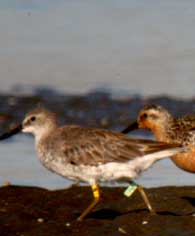 At the present time, there are several thousand Red Knots on the Kiawah beachfront. These medium-sized, migratory shorebirds are in the process of migrating from wintering grounds to the Arctic to breed. These birds may have flown more than 3,000 miles non-stop from South America to get here and are now trying to feed and rest to recover from their long journey. They also need to replenish their energy levels and fat stores so that they can continue another 1,500 or more miles up to the Arctic. It is vitally important that these birds are allowed to rest and feed without disturbance. Please keep your distance from these birds and do not walk or run through these flocks. Never allow dogs to chase these birds. Disturbance of these birds prevents them from feeding and forces them to expend unnecessary energy, which may result in their deaths.
At the present time, there are several thousand Red Knots on the Kiawah beachfront. These medium-sized, migratory shorebirds are in the process of migrating from wintering grounds to the Arctic to breed. These birds may have flown more than 3,000 miles non-stop from South America to get here and are now trying to feed and rest to recover from their long journey. They also need to replenish their energy levels and fat stores so that they can continue another 1,500 or more miles up to the Arctic. It is vitally important that these birds are allowed to rest and feed without disturbance. Please keep your distance from these birds and do not walk or run through these flocks. Never allow dogs to chase these birds. Disturbance of these birds prevents them from feeding and forces them to expend unnecessary energy, which may result in their deaths.
Red Knots are an imperiled species and numbers have dropped substantially in the last 20 years. They are currently being evaluated for listing on the Federal Endangered Species List.
March 12, 2012 ~ American Alligator (Alligator mississippiensis)
Presumably, due to the exceptionally mild winter we have been experiencing, today at Night Heron Park we saw the first signs of the alligator breading season. This is notably earlier than we observed in 2011.
Today, our resident female (~ 7 feet) was being courted by a large male (~9 feet). Although no bellowing or body posturing was observed, the male was definitely perusing the female throughout the length of the pond. Due to the fact that alligators are very territorial and due to this individual’s size, we believe it is safe to assume he is the same suitor as last year. Every morning for nearly 2 weeks in May 2011, we observed amazing bellowing, head-slapping, snout and back rubbing right outside the Nature Center.
March 10, 2012 ~ Belted Kingfisher (Megaceryle alcyon)
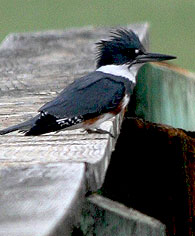 Kingsley, our resident Belted Kingfisher is about the only predictable wildlife in the salt marsh. He can be seen most mornings, surveying his kingdom from atop his oyster sign near the Mingo Point dock.
Kingsley, our resident Belted Kingfisher is about the only predictable wildlife in the salt marsh. He can be seen most mornings, surveying his kingdom from atop his oyster sign near the Mingo Point dock.
March 9, 2012 ~ Great Horned Owl (Bubo virginianus)
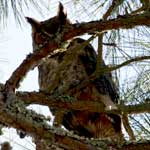 Day 4: This morning we went out to check the status of our little owlet. We were greeted by one of the parents who was intensely watching us from a close by branch. As the ladder went up, the adult showed more aggressive behavior by clicking its beak, hooting and jumping from limb to limb. Eventually, Naturalist Mike Frees was able to weigh the owlet but had to do so on the ladder since (for his safety) taking the baby down to the ground was not an option. The owlet weighed in at 616 grams, gaining 120 grams in 4 days.
Day 4: This morning we went out to check the status of our little owlet. We were greeted by one of the parents who was intensely watching us from a close by branch. As the ladder went up, the adult showed more aggressive behavior by clicking its beak, hooting and jumping from limb to limb. Eventually, Naturalist Mike Frees was able to weigh the owlet but had to do so on the ladder since (for his safety) taking the baby down to the ground was not an option. The owlet weighed in at 616 grams, gaining 120 grams in 4 days.
It was very exciting to see the parent owl acting so protective and proved to us that it is watching closely over it’s young as well as feeding it!
March 7, 2012 ~ Great Horned Owl (Bubo virginianus)
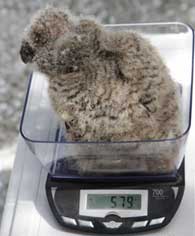 Day 2: Our little owlet is 579 grams. Still alert and healthy, it appears that the parents are continuing to feed it in the surrogate box. We will continue to monitor…and post updates here and on our facebook page.
Day 2: Our little owlet is 579 grams. Still alert and healthy, it appears that the parents are continuing to feed it in the surrogate box. We will continue to monitor…and post updates here and on our facebook page.
March 6, 2012 ~ Yellow Rat Snake (Elaphe obsoleta quadrivittata)
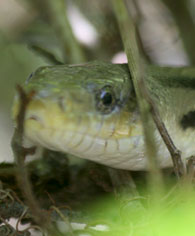 This beautiful Yellow Rat Snake was rescued today from our laundry facilities. It was presumably seeking refuge from the colder temperatures we have been experiencing on the island over the past few days. After a speedy capture by Naturalist Mike Frees, the four foot snake was released in the understory adjacent to Night Heron Park.
This beautiful Yellow Rat Snake was rescued today from our laundry facilities. It was presumably seeking refuge from the colder temperatures we have been experiencing on the island over the past few days. After a speedy capture by Naturalist Mike Frees, the four foot snake was released in the understory adjacent to Night Heron Park.
Yellow Rat Snakes are one of the most common species of snakes on Kiawah. An important predator on our island, adult rat snakes primarily eat mice, rats and squirrels. Rat snakes are constrictors, and adept climbers that can scale brick walls as well as tree trunks. If you need help identifying a Yellow Rat Snake, please visit the Nature Center, we currently have two in captivity.
March 6, 2012 ~ Great Horned Owl (Bubo virginianus)
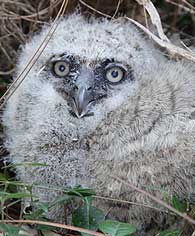 This morning, the Nature Center received a phone call regarding a young owl on the ground. Naturalist Nick Boehm, Brad Schmoll and Jamie Rood found this juvenile Great Horned Owlet that had fallen 60 feet from its nest high up in a pine tree.
This morning, the Nature Center received a phone call regarding a young owl on the ground. Naturalist Nick Boehm, Brad Schmoll and Jamie Rood found this juvenile Great Horned Owlet that had fallen 60 feet from its nest high up in a pine tree.
Upon consulting with the Avian Conservation Center (Center for Birds of Prey), it was decided that a “surrogate box” would be installed adjacent to the tree, with hopes that the parents will continue to feed and care for it. Under the direction of the experts at the Center for Birds of Prey, Kiawah Naturalists will monitor and weigh the young regularly to insure it is being feed. Currently our little owlet is approximately two weeks old, 496 grams and healthy. We will continue to post updates here and on our facebook page.
March 3, 2012 ~ Killdeer (Charadrius vociferus)
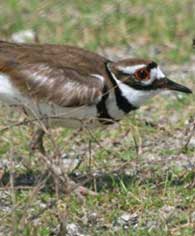 Our local population of Killdeer have returned to the west end of the island. Though considered a year round species, our particular population leaves the western section of the Kiawah River during the colder months. Sightings have occurred at both Fresh fields and the “mud flats,” behind the island.
Our local population of Killdeer have returned to the west end of the island. Though considered a year round species, our particular population leaves the western section of the Kiawah River during the colder months. Sightings have occurred at both Fresh fields and the “mud flats,” behind the island.
Mike Frees, Naturalist
March 2, 2012 ~ Feather Report
Today was a was an amazing day for birds of prey sightings, at the start of our kayaking trip we saw at least 2 Osprey (Pandion haliaetus) and a Cooper’s Hawk (Accipiter cooperii) circling the Kiawah River. Simultaneously, Naturalist Mike Frees spotted a Red-Tail Hawk (Buteo jamaicensis) near the bridge. Finally, once we got back into the marsh near Snake Island, we saw both the male and female Bald Eagle (Haliaeetus leucocephalus). We sat observing the nest for about 15 minutes and interestingly the female returned to the nest twice and dropped bits of what looked like fish into the nest, possibly feeding young? She’s been acting differently around that nest lately…
March 1, 2012 ~ Diamondback Terrapin (Malaclemys terrapin centrata)
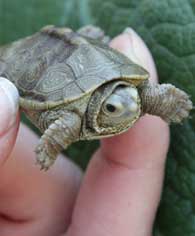 Today, we were lucky enough to have a couple and their granddaughter bring a hatchling terrapin into the Nature Center. At 8 grams and a 33 millimeters shell (carapace) length, this is the smallest terrapin we have seen. They found he/she over at Bohicket Marina while enjoying some ice cream, and due to its small size thought it would be best to bring it to us. Although sometimes it is best to leave young animals where they are, in this case we hope to raise it up to get a little bigger before we release it, hoping this will give it a better chance of survival.
Today, we were lucky enough to have a couple and their granddaughter bring a hatchling terrapin into the Nature Center. At 8 grams and a 33 millimeters shell (carapace) length, this is the smallest terrapin we have seen. They found he/she over at Bohicket Marina while enjoying some ice cream, and due to its small size thought it would be best to bring it to us. Although sometimes it is best to leave young animals where they are, in this case we hope to raise it up to get a little bigger before we release it, hoping this will give it a better chance of survival.
If you get a moment, come by to visit the newest member to our Nature Center family.
February 29, 2012 ~ Great Horned Owl (Bubo virginianus)
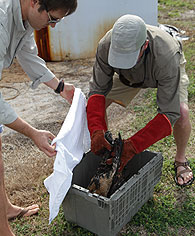 This morning, a Great Horned Owl was rescued by our rec. staff, Brad Schmoll, Mike Frees and Nick Reynolds. The call came in from the island’s water treatment plant and upon arrival it was obvious that this owl was and unable to fly. After a careful and speedy rescue, the owl was on its way to the Avian Conservation Center for evaluation.
This morning, a Great Horned Owl was rescued by our rec. staff, Brad Schmoll, Mike Frees and Nick Reynolds. The call came in from the island’s water treatment plant and upon arrival it was obvious that this owl was and unable to fly. After a careful and speedy rescue, the owl was on its way to the Avian Conservation Center for evaluation.
February 28, 2012 ~ Lightning Whelk (Busycon sinistrum)
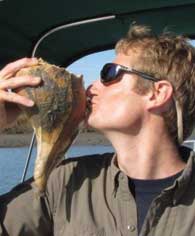 Whelk’s, frequently mistaken for conch’s, are one of the most common gastropod’s found on Kiawah’s beach and a favorite for the casual collector. Although similar in shape, Conch’s are not a frequent visitor to Kiawah’s beach and can be distinguished by what they eat; whelk’s being carnivores and conch’s being vegetarians. Three species of whelk (knobbed, channeled, and lightning) are found along the SC coast, each being easily identified. Knobbed Whelk’s (Busycon carica) have several spikes (knobs) that protrude from the spiral end, and have a dextral (right-handed) facing shell; Channeled Whelk’s (Busycotypus canaliculatus) have smooth grooves spiraling up to the tip, and also has a dextral facing shell; Lightning Whelk’s (Busycon contrarium) which are the least common of the three, have smaller knobs protruding from the spiral end similar to the knobbed, but has a sinistral (left-handed) facing shell.
Whelk’s, frequently mistaken for conch’s, are one of the most common gastropod’s found on Kiawah’s beach and a favorite for the casual collector. Although similar in shape, Conch’s are not a frequent visitor to Kiawah’s beach and can be distinguished by what they eat; whelk’s being carnivores and conch’s being vegetarians. Three species of whelk (knobbed, channeled, and lightning) are found along the SC coast, each being easily identified. Knobbed Whelk’s (Busycon carica) have several spikes (knobs) that protrude from the spiral end, and have a dextral (right-handed) facing shell; Channeled Whelk’s (Busycotypus canaliculatus) have smooth grooves spiraling up to the tip, and also has a dextral facing shell; Lightning Whelk’s (Busycon contrarium) which are the least common of the three, have smaller knobs protruding from the spiral end similar to the knobbed, but has a sinistral (left-handed) facing shell.
While out on the Kiawah River on our motorboat we were excited to encounter a very large lightning whelk (pictured) spotted by Captain Mike Frees along the bank of Captain Sam’s Inlet. Due to their importance to the marine ecosystem, taking too many shells from the beach can have a negative impact. However, if you are going to take any we suggest picking up a piece of trash for each shell you take!
February 25, 2012 ~ White Ibis (Eudocimus albus)
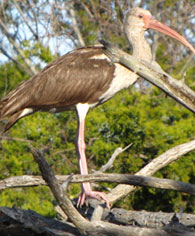 Normal for this time of year, we have been seeing good numbers of White Ibis on the island. Sometimes mistaken for Glossy Ibis, the large juveniles are brown instead of white and often hang out with other like minded individuals.
Normal for this time of year, we have been seeing good numbers of White Ibis on the island. Sometimes mistaken for Glossy Ibis, the large juveniles are brown instead of white and often hang out with other like minded individuals.
February 21, 2012 ~ Great Egret (Ardea alba)
After a notable absence, we are observing some activity at the Sea Marsh Drive rookery. This evening Naturalist, Jamie Rood, observed 20+ Great Egrets congregating in the trees.
Post your Kiawah rookery reports to Nature Program Facebook.
February 20, 2012 ~ Bottlenose Dolphin (Tursiops truncates)
This afternoon, guests watched a single dolphin strand feeding for nearly 30 minutes. Captain Brad reported the individual “took his entire body out of the water at least 10 times”. Photos were taken by our guest…we hope to post them soon.
February 20, 2012 ~ Bald Eagle (Haliaeetus leucocephalus)
Captain Bradley Schmoll reported 3 bald eagles (2 mature, 1 juvenile) sitting on the sand at Captain Sam’s Inlet.
February 15, 2012 ~ River Otter (Lontra canadensis)
 Kiawah guest, Maggie Dale (from Canada) captured this shot of a River Otter swimming in the Turtle Beach Pond.
Kiawah guest, Maggie Dale (from Canada) captured this shot of a River Otter swimming in the Turtle Beach Pond.
February 14, 2012 ~ Feather Report
 Tour: Highlights from Back Island Birding:
Tour: Highlights from Back Island Birding:
Guide: Mike Frees
The Preserve: Pied-billed Grebe, Tricolor Heron, Robin, Belted Kingfisher, Great Blue Heron, White Ibis, Red-winged Blackbirds
Willet Pond Area: Coots, Buffleheads, Horned Grebe, Pied-billed Grebe, Snowy Egret, Great Egret, Great Blue Heron
Willet Island: Great Egret, Yellow Rumped Warbler, Wood Stork, Osprey
Ocean Course: Wood Stork, Great Egret, Little Blue Heron, Tricolor Heron, Great Blue Heron, Belted Kingfisher
February 5, 2012 ~ White-tailed Deer (Odocoileus virginianus)
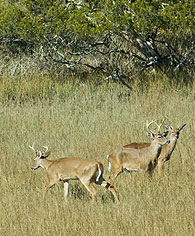 A total of six bucks and one doe were spotted by Kiawah Resident, Dave Elliot, in the marsh near Marsh Island Park.
A total of six bucks and one doe were spotted by Kiawah Resident, Dave Elliot, in the marsh near Marsh Island Park.
January 30, 2012 ~ Feather Report
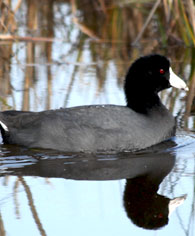 Tour: Back Island Birding
Tour: Back Island Birding
Weather: High of 72 with mixed on and off cloud cover
Guide: Mike Frees
Species List: Brown Headed Nuthatch, Gray Catbird, Yellow-rumped Warbler, Pine Warbler, Bufflehead, Hooded Meganser, Coopers Hawk, Great Blue Heron, Great Egret, Little Blue Heron, Tricolor Heron, Brown Pelican, Tern, Willet, Carolina Chickadee, Red-winged Black Bird, Robin, Coot, Moorhen, Ruddy Duck, Pied-billed Grebe, House Finch
January 26, 2012 ~ Cedar Waxwing (Bombycilla cedrorum)
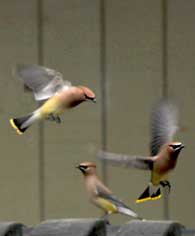 During a Wildlife in the Wetlands Bike Tour, we spotted a pair of Cedar Waxwings on the path to Marsh Island Park. The Cedar Waxwing is a fantastic bird and the collective nouns for these birds include an “ear-full,” or a “museum.” These birds breed from the Northern United States up into Canada, however during the winter months they can be found here in South Carolina. During courtship a mating pair can be spotted passing either insects or small twigs back and forth to strengthen the mating bond. Cedar Waxwings are some of the most specialized fruit- eating birds, rather than regurgitating seeds they will actually pass the seeds through waste. Recently, more and more Cedar Waxwings have been spotted with orange terminal bands rather than the typical yellow, these vicissitudes have been attributed to the consumption of invasive honeysuckle and the pigments found within. If you’re trying to spot a Cedar Waxwing look near the margins of wooded areas near freshwater, around here your best bet will be to look around the edges of our many golf courses.
During a Wildlife in the Wetlands Bike Tour, we spotted a pair of Cedar Waxwings on the path to Marsh Island Park. The Cedar Waxwing is a fantastic bird and the collective nouns for these birds include an “ear-full,” or a “museum.” These birds breed from the Northern United States up into Canada, however during the winter months they can be found here in South Carolina. During courtship a mating pair can be spotted passing either insects or small twigs back and forth to strengthen the mating bond. Cedar Waxwings are some of the most specialized fruit- eating birds, rather than regurgitating seeds they will actually pass the seeds through waste. Recently, more and more Cedar Waxwings have been spotted with orange terminal bands rather than the typical yellow, these vicissitudes have been attributed to the consumption of invasive honeysuckle and the pigments found within. If you’re trying to spot a Cedar Waxwing look near the margins of wooded areas near freshwater, around here your best bet will be to look around the edges of our many golf courses.
Matt Arnold, Naturalist
January 25, 2012 ~ Bottlenose Dolphin (Tursiops truncates)
 Kiawah Naturalists had an unexpected surprise today … a pair of dolphin feeding in the lagoon at the end of the Ocean Course driving range.
Kiawah Naturalists had an unexpected surprise today … a pair of dolphin feeding in the lagoon at the end of the Ocean Course driving range.
January 24, 2012 ~ White-tailed Deer (Odocoileus virginianus)
Town biologists have conducted Kiawah’s Winter Deer Spotlight Survey. They saw a total of 92 deer, including 25 bucks, 32 does, 7 fawns, and 28 unidentified deer. The deer density estimate from this survey was 53 deer per square mile, well within management goals.
January 21, 2012 ~ Feather Report
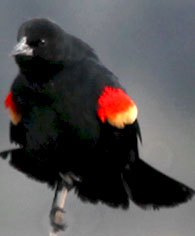 Our Back Island Birding trip was a true showcase of the avian biodiversity on Kiawah Island. Beginning at Mingo Point, we were able to spot Eastern Bluebirds, Double-crested Cormorants, Red-Winged Blackbirds, Great and Snowy Egrets, Yellow-rumped and Pine Warblers, Northern Mockingbirds, a Common Loon, a single Tufted Titmouse, a banditry of Carolina Chickadees, a couple of House Finches, a Bufflehead and a Tricolored Heron. Just as we were about to depart for the next location, a Bald Eagle came soaring in above our heads. Following Mingo Point we made a brief stop at the pond next to the Cougar Point clubhouse to get a look at a raft of Hooded Mergansers. Our tour then took us to some of the ponds throughout the Preserve and we were able to find another Tricolored Heron, a Belted Kingfisher and a Green Heron. While at the preserve we were also able to “Bubba,” the infamous American Alligator who appears to be between roughly 12 and 13 feet long. In search for an Osprey nest, we made a brief stop across from Willet Pond, and although the nest was empty, our very own Tom Burgess spotted an Osprey riding thermals in the distance. Running short on time, we stopped by Turtle Pond and as usual the bird activity was amazing. Species spotted included, two Black-crowned Night Herons, a Tricolored Heron, American Coots, Common Gallinules, a Belted Kingfisher, Pied-billed Grebes, Ring-billed Gulls, additional Great Blue Herons and Great Egrets to boot.
Our Back Island Birding trip was a true showcase of the avian biodiversity on Kiawah Island. Beginning at Mingo Point, we were able to spot Eastern Bluebirds, Double-crested Cormorants, Red-Winged Blackbirds, Great and Snowy Egrets, Yellow-rumped and Pine Warblers, Northern Mockingbirds, a Common Loon, a single Tufted Titmouse, a banditry of Carolina Chickadees, a couple of House Finches, a Bufflehead and a Tricolored Heron. Just as we were about to depart for the next location, a Bald Eagle came soaring in above our heads. Following Mingo Point we made a brief stop at the pond next to the Cougar Point clubhouse to get a look at a raft of Hooded Mergansers. Our tour then took us to some of the ponds throughout the Preserve and we were able to find another Tricolored Heron, a Belted Kingfisher and a Green Heron. While at the preserve we were also able to “Bubba,” the infamous American Alligator who appears to be between roughly 12 and 13 feet long. In search for an Osprey nest, we made a brief stop across from Willet Pond, and although the nest was empty, our very own Tom Burgess spotted an Osprey riding thermals in the distance. Running short on time, we stopped by Turtle Pond and as usual the bird activity was amazing. Species spotted included, two Black-crowned Night Herons, a Tricolored Heron, American Coots, Common Gallinules, a Belted Kingfisher, Pied-billed Grebes, Ring-billed Gulls, additional Great Blue Herons and Great Egrets to boot.
Matt Arnold, Naturalist
January 17 2012 ~Common Loon (Gavia immer)
As a child, I spent most of my summers on a lake in Northern Minnesota and those memories are forever entwined with the almost haunting call of the Common Loon at dusk. It is then, only fitting that the Common Loon or the Great Northern Loon is the state bird of Minnesota. Additionally the bird makes an appearance on the Canadian coin known as the “loonie” (worth roughly 92 cents U.S.). The bird is an extremely capable diver with eyes that can focus in and out of the water, as well as abnormally dense bones that allow it to make dives of up to 200ft. While the Common Loon spends it’s summers in the Great North, it is a winter resident in the Lowcountry.
Unfortunately, today, the Town’s Beach Patrol brought an injured Common Loon to the Nature Center that had incurred left to right dorsal wounds across it’s back and down it’s leg. The bird was taken to the Avian Conservation Center in Awendaw. Sadly, the loon passed away due to injuries sustained by a boat propeller, which tends to be a common demise for diving birds.